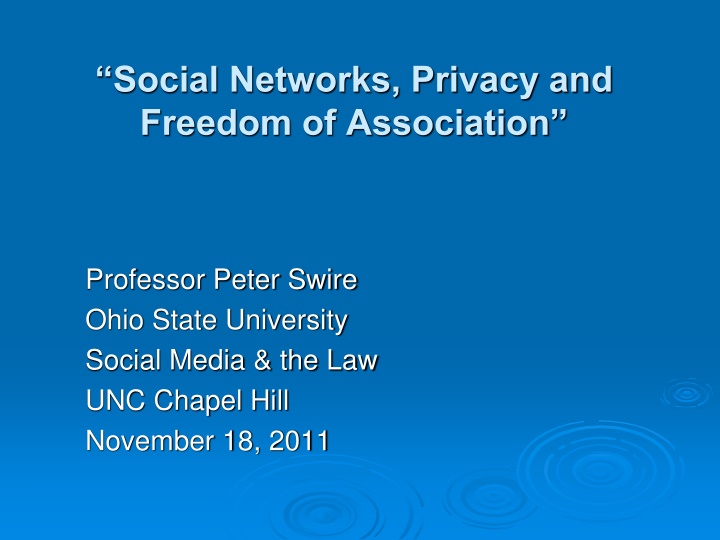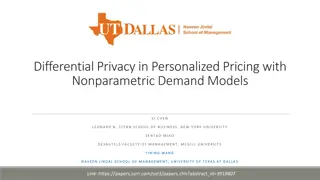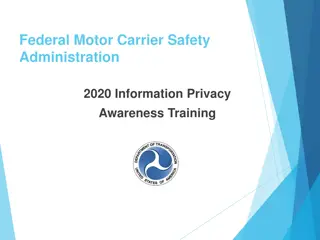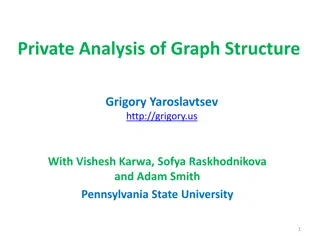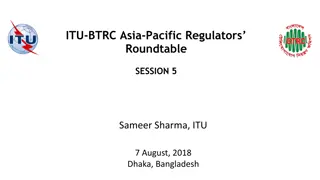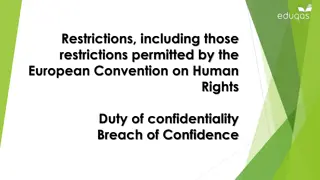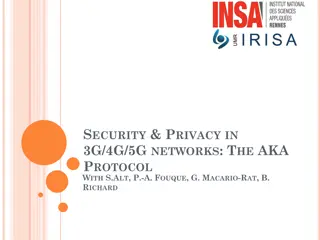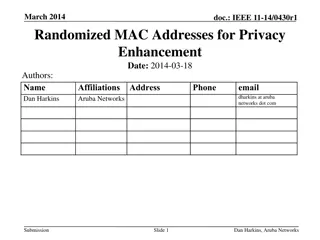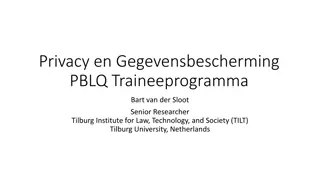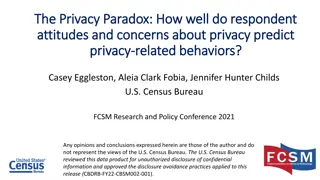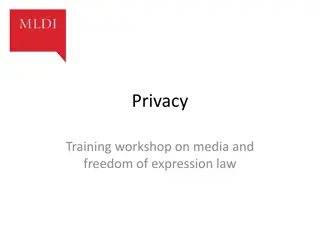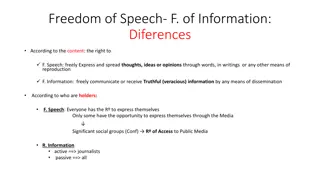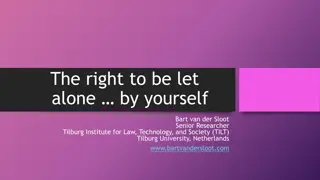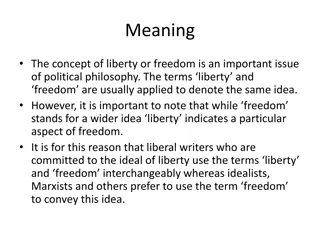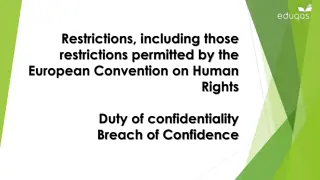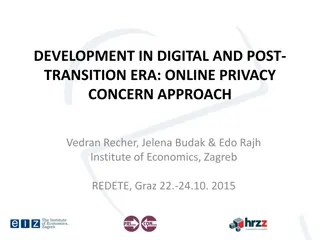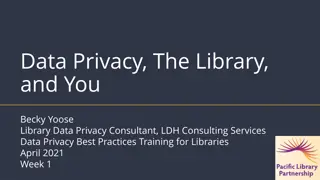Social Networks, Privacy, and Freedom of Association in the Digital Age
Explore the intersection of social networks, privacy, and freedom of association through discussions on platforms for political mobilization, privacy concerns, state actions, and the impact on expressive association rights. Learn from historical cases like NAACP v. Alabama and delve into contemporary issues like privacy by design initiatives and challenges in regulating associations on social networks.
Download Presentation

Please find below an Image/Link to download the presentation.
The content on the website is provided AS IS for your information and personal use only. It may not be sold, licensed, or shared on other websites without obtaining consent from the author.If you encounter any issues during the download, it is possible that the publisher has removed the file from their server.
You are allowed to download the files provided on this website for personal or commercial use, subject to the condition that they are used lawfully. All files are the property of their respective owners.
The content on the website is provided AS IS for your information and personal use only. It may not be sold, licensed, or shared on other websites without obtaining consent from the author.
E N D
Presentation Transcript
Social Networks, Privacy and Freedom of Association Professor Peter Swire Ohio State University Social Media & the Law UNC Chapel Hill November 18, 2011
Overview Linguistics: network and association Social networks as platforms for association 2. Cyber conferences 1. 1. 1. One panel on political mobilization celebrate sharing of personal information 2. One panel on privacy concern about sharing of personal information 3. Towards an integrated view spotting the issues, intellectual structure 3. Doctrine on possible state action 1. Privacy by design ; Do Not Track 2. Do Not Track, even for political parties and non-profits 4. Data empowerment v. data protection
Network & Association Linguistics: network and association Also, links , relationships Circles form groups and associations 2. Social networks as locus of political mobilization 1. 1. 2. 1. Egypt, Tunisia, Arab spring 2. Obama campaign: New Media, and get friends to get friends to knock on doors 1. A different progressive view of privacy 3. Tea Party 1. Senator Brown; not a left/right split 3. Social media central to associational activity 1. Already by 2009, 97% of charities in the U.S. used some form of social media 2. 2011 Pew study: majority of online users in the US have been invited via Internet to join a group; 38% have used the Internet to invite others to join a group
1stAmendment Doctrine 1. Possible state action to govern associations in social networks 2. Expressive association, not intimate 3. Strict scrutiny thus far test for association, ok if: 1. Compelling state interest 2. Unrelated to the suppression of ideas 3. That cannot be achieved through means significantly less restrictive of associational freedom 4. Perhaps commercial association 1. Social network challenges its ability to supply association 5. Perhaps time, place, and manner association 1. Some aspects of social networks are regulated, while allowing ample alternative channels for association
Previously on Privacy & Association 1. NAACP v. Alabama: state wanted membership list of NAACP members 2. Alabama lost: 1. Privacy interest of members, chilling effect if their association links revealed 2. Chilling as well of the NAACP s associational rights 3. Limit on data flow supported freedom of association 3. Applied to social networks: 1. Freedom of association (to protect privacy) can be a state interest justifying privacy limits 2. As applied in a case, look at privacy rule s restrictions on freedom of association (limit on data flows) and also its advancement of freedom of association (protect individuals from revealing their memberships)
Example 1: Privacy by Design 1. Issue: legal mandate of privacy by design 1. Plaintiff can be a political campaign or non-profit, and wants outreach by design 2. Plaintiff can be the social network, claiming commercial association rights violated by limits on the platform 3. Facts matter effects on association, other alternatives 4. Doctrine matters strict, commercial, or TPM scrutiny
Example 2: Do Not Track 1. Do Not Track unclear on details: 1. May limit display of targeted ads (industry view) 2. May limit collection of information across multiple sites (Cranor and tracking ) 2. For display-only version of DNT 1. This is the outreach by the organization to find people likely to be interested in joining the association or participating in a campaign/activity 2. May be strong argument for exception for political campaigns and non-profits, as with Do Not Call 3. For collection limits version of DNT 1. Goes deeper into architecture of what data created & shared 2. May be harder for challengers to say need accommodation specifically for political campaigns and non-profits
Data Empowerment v. Data Protection Usual statement, in E.U. and more broadly Fundamental/human right to privacy protection Rights of the data subject Form of the argument: the individual s rights should outweigh utility (cost/benefit) arguments, and privacy should win Additional point today Fundamental right of freedom of association can be limited if the state protects privacy Form of the argument: the individual s rights to privacy (limit social networking sharing) are contrasted with an individual s right to form and further associations (expand social networking sharing) Similar to Volokh s right to speak truthfully about another person Here, the distinct right to associate effectively is at issue Data empowerment v. data protection doctrine and policy 1. 1. 2. 2. 3. 1. 2. 4. 5. 6.
Conclusion Towards integrated intellectual structure for social networks as: Platforms for association (share data) Platforms for privacy invasion (limit sharing) Individuals ourselves (and our non-profits and political groups) Split within our psychology data empowerment & protection Legal doctrine Will need development of FOA law for association platforms Practical politics This is how politicians do their outreach, so may be hard to enact limits on association (NPR story) Policy Whatever is constitutional, question of how to achieve both goals Discussion of only one goal misses our dual aspirations
